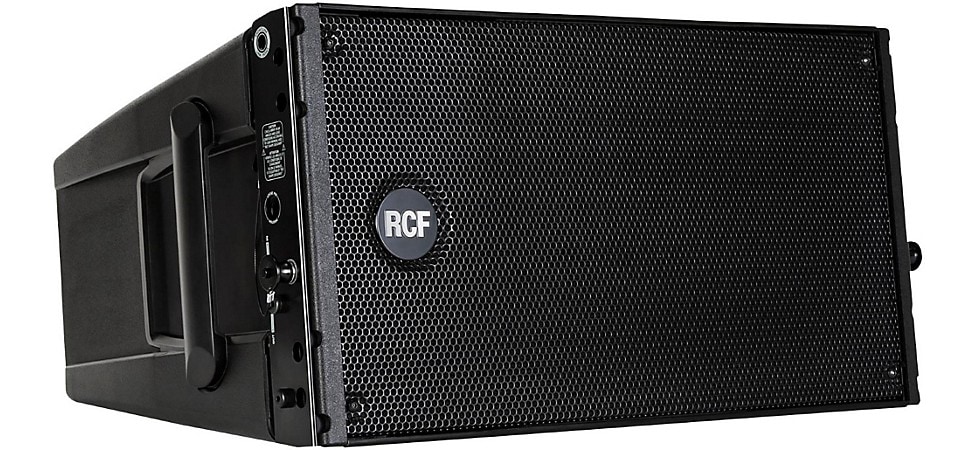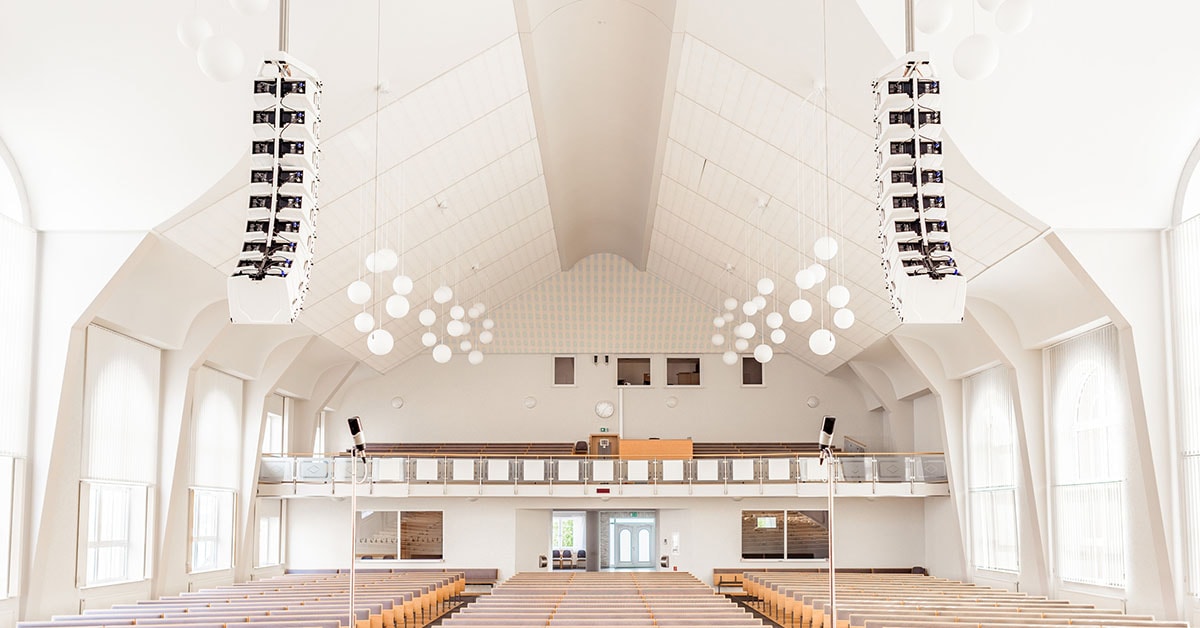(Image courtesy of RCF)
Every house of worship facility needs a clear, functional PA system. Whether you're a small congregation handling sermons or discourses, or a mega-church with full multisensory experiences, sound quality and intelligibility are key to inspiring and motivating the audience. However, as music styles, parishioner expectations and line array technology all continue evolving, so do the needs and requirements of house of worship PA systems.
For many years, houses of worship used traditional “point source” loudspeakers almost exclusively. These types of systems provide excellent, functional sound, and they’re affordable and easy to mount without affecting line-of-sight in your sanctuary. However, thanks to advances in technology and more affordable and compact options, line array systems are an increasingly popular choice for sound reinforcement in houses of worship. Line array PA systems vertically stack multiple speaker cabinets rather than using a single point source speaker, providing very wide horizontal dispersion.
Today, there are line array speaker systems available for houses of worship of a wide range of sizes, from smaller sanctuaries to large 10,000+ seat worship centers. However, the number of options available can make it hard to find the best choice for your house of worship if you’re new to line array speaker systems.
In this blog, we’ll take a look at line array systems and the benefits they can bring to houses of worship. We’ll demonstrate how line arrays work, discuss the benefits of line array technology, and explain how the solutions engineers at Guitar Center Professional can help you find the perfect line array system for your house of worship with our white glove service.
What are line array speakers?
Technically speaking, a single line array cabinet is just a box speaker. However, a line array cabinet is not designed to work on its own. Point source speakers have a defined horizontal and vertical coverage pattern, and have been built to cover a particular (typically rectangular) shape. Line array speakers, on the other hand, are designed to be put together in a vertical stack and have a narrow vertical coverage angle and a wider horizontal angle.

Pictured: RCF HDL 10-A Active Line Array Module
For example, the RCF Art 745-A MK4 Active 2-Way Speaker has a 90° x 60° coverage pattern, allowing it to cover a broad area. The RCF HDL 10-A Active Line Array Module, on the other hand, has a 100° x 15° coverage pattern, meaning it has a wide horizontal angle but a very narrow vertical angle. Multiple line array cabinets/modules are then stacked together to tailor the vertical angle to the space.
How line array speakers work
The benefit of using a line array in a space is the ability to adjust the individual cabinets within the stack to target sound at specific areas of the sanctuary. Line array stacks can be precisely angled and calibrated to provide balanced sound both at the front and the rear of the audience.
The experts from Guitar Center Professional’s white glove service achieve this by precisely angling the various cabinets in the array to direct sound where people will be sitting while minimizing sound pointing at reflective surfaces such as walls, ceilings, floors or other surfaces that create echo in the space.
For example, in some spaces, line array stacks (or clusters) are hung in a J-shaped pattern to better target the sound. The bottom curve of the “J” points sound at people near the stage, while the top, straight portion of the stack points sound at those at the rear of the space. This ensures a consistent sound experience for everyone in the sanctuary.
The sound engineers then adjust the amplitude of the individual line array speakers so the speakers pointing toward the rear of the audience are set to a higher output, while the speakers directed at the front are turned down lower, because the sound doesn’t have to travel as far. The goal of this is to ensure as consistent a sound pressure level (SPL) across the entire audience to minimize the presence of “loud” or “quiet” seating areas.
What to consider when purchasing a line array system
When beginning the search for any house of worship sound system, the first step should be reaching out to Guitar Center Professional. Our solutions engineers are here to take the guesswork out of purchasing a line array system and guide you through the process with our white glove service. It starts by using industry-standard modeling software to determine if a line array is a good fit for your space. Once confirmed, there are still a lot of things our solutions engineers consider when making a recommendation for the best speaker options for your application.
First and foremost, the engineer will consider the size and weight of the speakers. Line array stacks are, by definition, larger than point source speakers, and it’s important to consider the proposed hanging points to ensure they can handle the full weight of all the modules in the stack.
Secondly, the engineer will also look at sightlines. Taller line array stacks can hang fairly low, and it’s important to consider the mounting location and ceiling height compared to where the audience sits within the space. This is particularly true for audience members seated on the sides near the front. As well, the engineer will want to ensure the line array doesn’t block the throw of any projectors within the space, particularly if you have projector screens on the sides of the stage, rather than a center-mounted projector. And because the speakers will be visible within the space, you'll need to determine early whether you want your speakers to be white or black, so your Guitar Center Professional representative can ensure the speaker is available in a white option if you need it.
Another consideration for line arrays is power and signal processing. Some line arrays are “active,” meaning they have a built-in amplifier that’s power-matched to the speaker, as well as a built-in digital signal processor (DSP) that adjusts the sound to prevent damage to the drivers. Loudspeaker drivers are only capable of generating certain frequencies and need to have a DSP separate from the console that is adjusted to the frequency capabilities of the speaker. Having proper speaker tunings (as they’re called) and a power-matched amplifier is vital to the longevity of your speaker, and active speakers have both built-in.
There are also a number of “passive” line array systems that require a separate amplifier and DSP. These are still fine speaker options, but you'll need to have available space for racks to mount the amplifiers (as well as the DSPs, if the amplifiers don’t have DSPs built in), and the rack space should be easy to access for maintenance purposes.
Another consideration when selecting line array speakers for churches is the complement of drivers in the cabinet. This is one of the most distinctive differences between line array options, and it’s important to consider the performance and cost trade-offs of the different setups. As we mentioned previously, speaker drivers are designed to only generate certain frequencies, and speakers include multiple drivers of different sizes to generate the full range of sound. Speakers will typically have both low-frequency (LF) and high-frequency (HF) drivers, with some speakers also including mid-frequency (MF) drivers as well.
While the arrangements of drivers vary, there are a few common types that you'll run across. The most basic driver setup you'll encounter is a two-way speaker with a single LF driver. When we say a speaker is a “two-way” speaker, we mean they have two speaker types, an LF driver and an HF driver. Line array speakers that have this speaker setup, like the QSC KLA12, are ultracompact and affordable, but the single low-frequency driver offers some trade-off in performance, particularly low-end performance, versus other speaker arrangements.

Pictured: QSC KLA12 Active Line Array Speaker
A step up from this setup is a two-way speaker with two LF drivers. Line array speakers with this setup, such as the RCF HDL 10A we have been discussing, include two LF drivers on either side of the cabinet, and an HF driver in the middle. This can provide better coverage and performance than a single-driver setup, depending on the size of the drivers (more on that in a moment). For even more improved performance, some line arrays are available with three-way cabinets that add MF drivers to the mix. These speakers typically include two LF drivers, as well as one or more MF and HF drivers. By having dedicated drivers to create these middle frequencies, these speakers provide smoother, more consistent sound than two-way line array modules, but are often more expensive.
As we mentioned a moment ago, a related consideration to the arrangement of drivers is the size of the driver. The RCF HDL 10A has two LF drivers compared to the QSC KLA12’s single LF driver, but they’re similarly priced because the QSC KLA12 includes a 12" driver compared to the two 8" LF drivers on the RCF HDL 10A. A larger driver is going to provide better low-end performance, because it’s physically capable of generating better low-end frequencies. This is why it’s a good idea to hear different speakers in action to determine the best choice for you.
As we have said, there are a number of different line array speaker options available for houses of worship, and they can be customized to fit a variety of sanctuary sizes. To get expert assistance, you can always call Guitar Center Professional at 877-687-5404, and we’ll help you identify the best speaker system for your specific needs.




